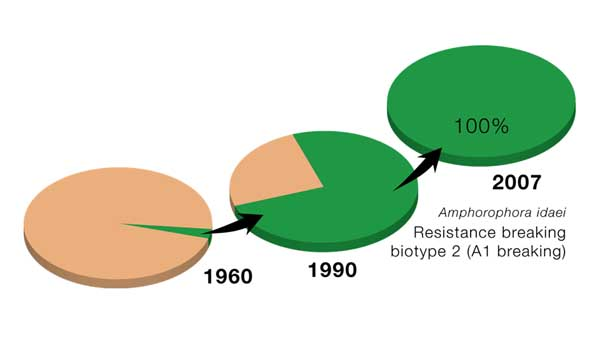Food Web Studies On Raspberries
Published on 19 March 2010 in Ecosystems and biodiversity

Introduction
Functional biodiversity (food webs in agro-ecosystems) delivers vital ecological services such as biocontrol of pests and crop pollination. Our research approach focuses on raspberry, because it is a high value crop important to Scotland, providing a locally grown source of health-promoting bioactives to consumers all year.
Current EU and UK policy (91/414 EEC, EU Sustainable Use Directive and the Water Framework Directive) mean there is effectively a zero tolerance of pesticide residues on fresh fruit. This poses a serious new problem for Scottish raspberry growers, particularly when climate change and protected cropping have greatly increased the prevalence of key pests, including virus transmitting aphids and raspberry beetle.
At SCRI we have been studying sustainable crop protection of raspberry for more than 30 years. Our aim is to develop Integrated Pest and Disease Management (IPDM) which combines several control strategies, including the use of pest resistant varieties, pest attractants, enhanced biocontrol agents (parasitoids, predators) and ‘ecological engineering’ of surrounding habitats (hedges, margins, woodlands) to increase sustainability and reduce pesticide reliance.
Our approach is multidisciplinary and operates at several scales:
• behaviour and chemoreception of specific host plant signals by individual insects
• field scale trials of new ideas for IPDM, centred on understanding key species interactions in agricultural food webs
• on-farm demonstrations of IPDM, via LEAF supported Hortlink and EU projects
• habitat manipulation and landscape scale ecology (‘ecological engineering’ and area wide IPDM, linked to modelling).
Key Points
Traditionally we have relied heavily on breeding for resistance against key pests such as raspberry aphids. However, due to selection pressure and accelerated co-evolution in polytunnels, virulent aphid biotypes can overcome plant resistance genes.
We are now at a critical ‘tipping point’ where aphids can overcome resistance genes faster than we can breed new varieties with stronger forms of pest resistance (see Fig. 1). At the same time, growers have fewer pesticides in their arsenal to control these pests.
IPDM offers the best solution for increasing durability of pest resistant crops, by spreading pressures across multiple strategies, including biocontrol, use of semiochemicals (attractants, repellents and biopesticides targeted by precision pest monitoring).

Figure 1: Due to prolonged dependence on aphid resistance R genes we have selected virulent aphid biotypes which can break resistance. The first R gene lasted > 30 years but the second R gene is breaking down in less than 10 years.
Our raspberry food web research demonstrates that although protected cropping significantly increases pest numbers (three species of aphids, raspberry beetle) inside polytunnels, there is far more scope to enhance biocontrol using endemic and/or introduced predators, parasitoids and fungal pathogens.
We use a technique developed in studies of GM crop ecosystems to select the most important interactions in the food web. In raspberry, we are focussing on spiders, lacewings, hoverflies and a complex of fungal pathogens as biocontrol agents which help to naturally suppress aphid populations.
We have also developed a precision monitoring tool for another key pest, the raspberry beetle, based on ‘bio-mimicry’ of the key features of a raspberry flower that attract this pest (colour and smell). This trap and lure is now being used by growers and gardeners to detect ‘hot spots’ of the pest and optimise the timing of control sprays, minimising pesticide use (see Fig. 2).
.jpg)
Figure 2: Raspberry beetle and raspberry beetle traps.
We also use these precision traps in underpinning ecological research. We have found regional and site specific features of the landscape (hedgerows, wild hosts in forests, old raspberry plantations) which have a strong influence on the migration of pests between wild plant habitats and crops.
This ecological information is vital to fine tune IPDM solutions for specific growers in different regions and countries using different crop managements (for example, organic in Norway, conventional in UK).
Research Undertaken
We use fundamental chemical ecology, computerised insect behavioural studies and electrophysiology to identify the key plant signals that are used by insects to locate host plants or insect prey.
At the next scale we test ecologically based hypotheses about potential IPDM tools in the field, working on-station and on-farm. These provide additional spatio-temporal information which is critical to understanding insect-plant interactions and movement between plants, fields and landscapes.
Finally, we work closely with industry, policy makers and end users (RERAD, Hortlink, EU-funded research) to deliver IPDM products and promote this approach via the SCRI LEAF Innovation Centre and Open Days.
Policy Implications
IPDM is now recognised as a central strategy for sustainable crop protection under 91/414 EEC. Growers should be further encouraged to promote biocontrol by carefully managing their hedgerows, field margins and surrounding habitats at field and landscape scales (for example, Linking Environment and Farming audit). By combining pest-resistant crops, semiochemicals and enhanced biocontrol it is possible to significantly reduce pesticide use on fresh fruit. We recently demonstrated (Hortlink project) that our IPDM system gives as good pest and disease control as current standard practice whilst reducing pesticide use. This is a win-win for growers, consumers and the environment.
Author
Dr Nick Birch, SCRI Nick.Birch@scri.ac.uk







